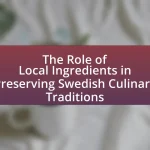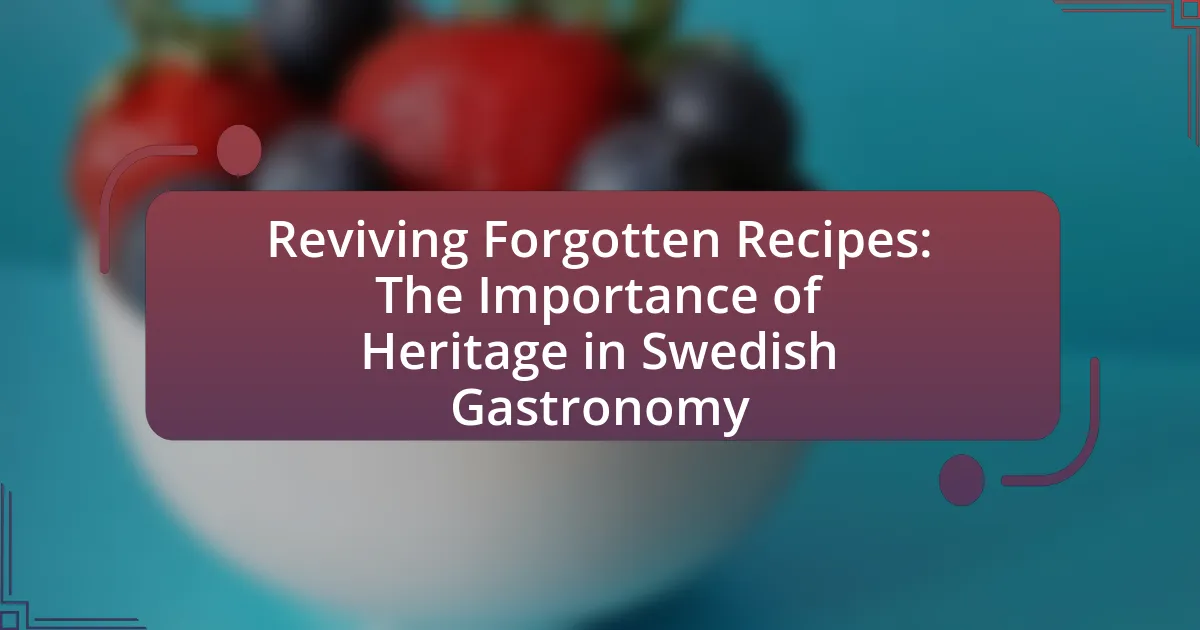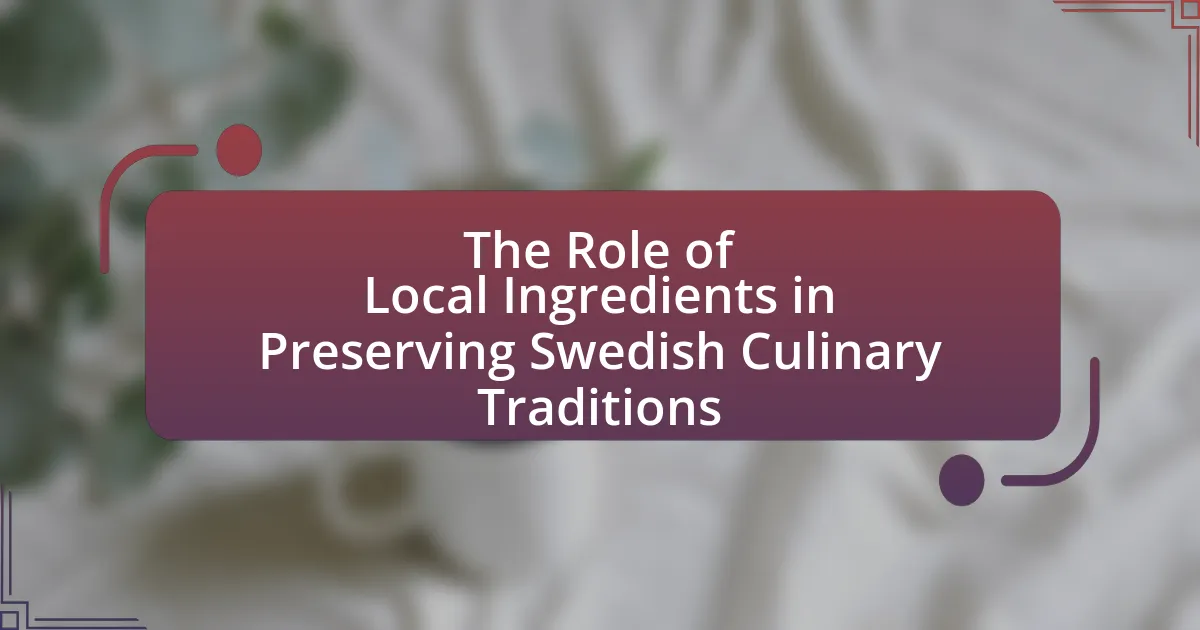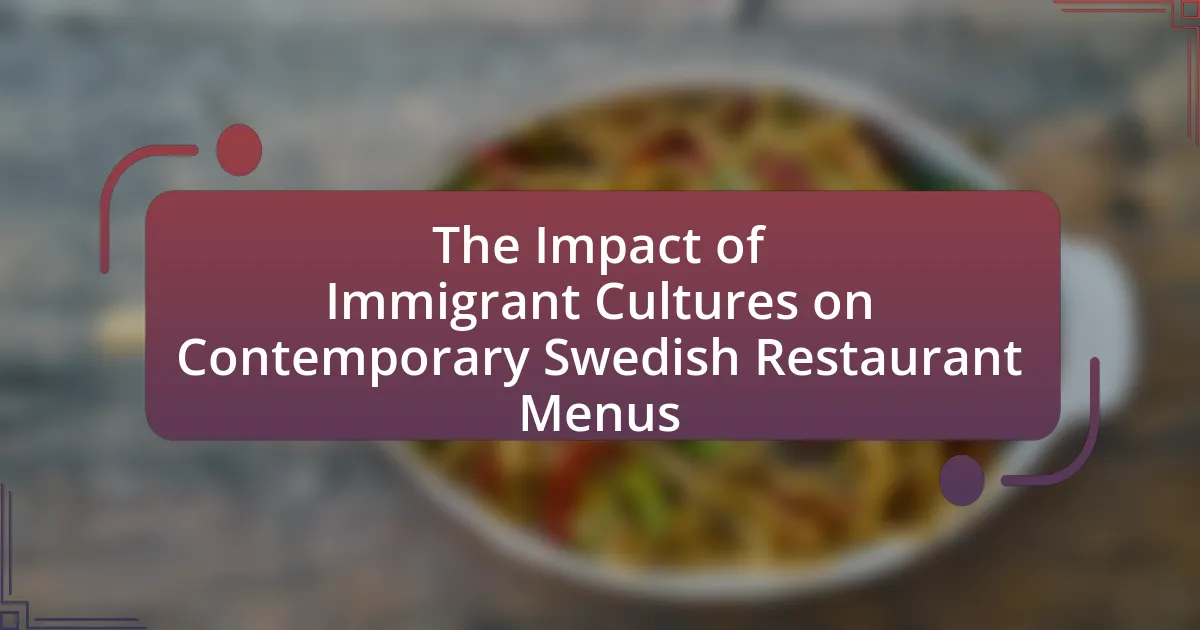The article examines the significant influence of Viking history on modern Swedish dining, highlighting how traditional ingredients and cooking methods from the Viking Age continue to shape contemporary cuisine. It explores the use of locally sourced foods, preservation techniques, and communal dining practices that have persisted through generations. Key topics include the ingredients commonly used in Viking-era cuisine, the impact of Viking trade routes on food availability, and the revival of ancient cooking techniques in today’s culinary landscape. Additionally, the article discusses the challenges and opportunities in merging Viking heritage with modern dining trends, as well as practical tips for home cooks to incorporate Viking influences into their meals.
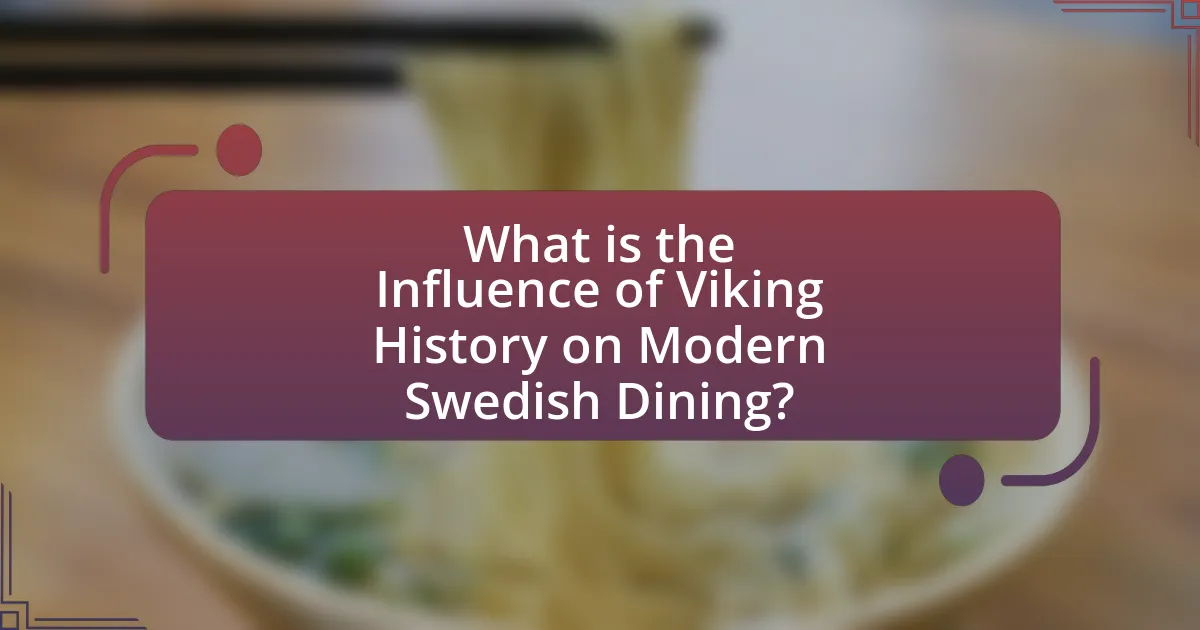
What is the Influence of Viking History on Modern Swedish Dining?
Viking history significantly influences modern Swedish dining through the incorporation of traditional ingredients and cooking methods. The Vikings relied heavily on locally sourced foods such as fish, game, and grains, which remain staples in contemporary Swedish cuisine. For instance, dishes like gravlax (cured salmon) and various meat stews reflect the preservation techniques and flavors that originated during the Viking Age. Additionally, the communal dining practices of the Vikings, which emphasized sharing and feasting, continue to shape social dining experiences in Sweden today, evident in the popularity of smörgåsbord and festive gatherings. This connection to Viking heritage is further reinforced by the use of traditional herbs and spices, such as dill and juniper, which have been passed down through generations.
How did Viking culture shape early Swedish culinary practices?
Viking culture significantly shaped early Swedish culinary practices through the introduction of new ingredients, cooking techniques, and preservation methods. The Vikings, known for their seafaring and trading, brought various foods from their travels, including spices, grains, and fish, which became staples in Swedish diets. They utilized methods such as smoking, drying, and fermenting to preserve food, which influenced how early Swedes prepared and stored their meals. Historical evidence, such as archaeological findings from Viking settlements, shows that these practices laid the foundation for modern Swedish cuisine, emphasizing the importance of local ingredients and preservation techniques that are still prevalent today.
What ingredients were commonly used in Viking-era Swedish cuisine?
Viking-era Swedish cuisine commonly used ingredients such as barley, rye, oats, fish, game meats, and dairy products. Barley and rye served as staple grains for bread and porridge, while oats were often used in various dishes. Fish, particularly herring and salmon, was abundant due to Sweden’s extensive coastline, and game meats like deer and wild boar were hunted for protein. Dairy products, including cheese and butter, were also significant in their diet, reflecting the agricultural practices of the time. These ingredients highlight the reliance on local resources and the adaptation to the Nordic environment, which shaped the culinary traditions that influence modern Swedish dining.
How did Viking trade routes impact food availability in Sweden?
Viking trade routes significantly enhanced food availability in Sweden by facilitating the exchange of various agricultural products and resources. These routes connected Sweden to regions such as the British Isles, the Mediterranean, and the Baltic, allowing for the importation of grains, spices, and preserved foods. Historical evidence shows that through trade, Vikings brought back items like barley and rye, which improved local diets and agricultural practices. Additionally, the exchange of fish, meat, and dairy products from different regions diversified the food supply, contributing to a more varied and nutritious diet for the Swedish population during the Viking Age.
What are the key Viking traditions that persist in Swedish dining today?
Key Viking traditions that persist in Swedish dining today include the emphasis on communal meals, the use of preserved foods, and the incorporation of local ingredients. Communal dining reflects the Viking practice of gathering for feasts, which is evident in modern Swedish traditions like “smörgåsbord,” where a variety of dishes are shared among guests. The Vikings relied heavily on preservation methods such as smoking, pickling, and fermenting, which continue to influence Swedish cuisine through dishes like pickled herring and cured meats. Additionally, the Viking focus on utilizing locally sourced ingredients is still prevalent, as Swedish cuisine often highlights seasonal produce and regional specialties, aligning with the Viking ethos of sustainability and resourcefulness.
Which traditional dishes have Viking origins?
Traditional dishes with Viking origins include haggis, porridge, and various types of fermented fish. Haggis, a dish made from sheep’s stomach filled with offal, has roots in Viking cooking methods that utilized all parts of the animal. Porridge, often made from oats or barley, was a staple in Viking diets, providing essential carbohydrates. Fermented fish, such as herring, was a preservation method used by Vikings to ensure food availability during long voyages. These dishes reflect the resourcefulness and dietary practices of the Viking era, influencing modern Swedish cuisine.
How do communal dining practices from the Viking age influence modern meals?
Communal dining practices from the Viking age significantly influence modern meals by fostering a sense of community and shared experience during dining. In Viking society, communal feasts were central to social gatherings, where food was shared among participants, promoting bonding and cooperation. This tradition persists today in modern Swedish dining, where communal meals, such as smorgasbord and family-style dining, encourage interaction and connection among diners. The emphasis on sharing food reflects the Viking value of hospitality and togetherness, which continues to shape contemporary dining culture in Sweden.
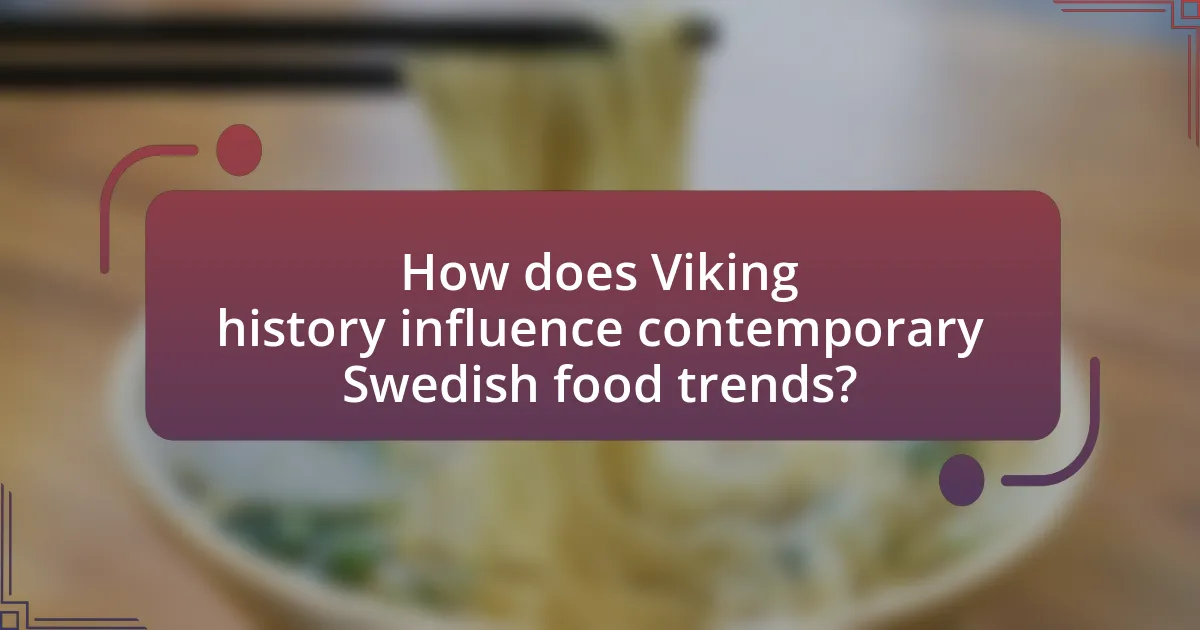
How does Viking history influence contemporary Swedish food trends?
Viking history significantly influences contemporary Swedish food trends by emphasizing the use of local, seasonal ingredients and traditional preservation methods. The Vikings relied on foraging, fishing, and farming, which has led to a modern focus on sustainability and the farm-to-table movement in Sweden. For example, dishes featuring herring, root vegetables, and rye bread reflect Viking dietary staples and are prevalent in contemporary Swedish cuisine. Additionally, the Viking practice of fermenting foods, such as pickling herring and fermenting vegetables, continues to inspire modern culinary techniques, promoting a revival of traditional methods in Swedish gastronomy.
What modern dishes reflect Viking culinary influences?
Modern dishes that reflect Viking culinary influences include gravlax, a cured salmon dish, and haggis, which showcases the use of offal and spices. Gravlax is prepared by curing salmon with a mixture of salt, sugar, and dill, a technique that dates back to Viking times when preservation methods were essential for long voyages. Haggis, while more commonly associated with Scottish cuisine, shares similarities with Viking-era dishes that utilized various animal parts and grains, reflecting the resourcefulness of Viking cooking. These dishes highlight the enduring legacy of Viking culinary practices in contemporary Scandinavian cuisine.
How are ancient cooking techniques being revived in modern Swedish cuisine?
Ancient cooking techniques are being revived in modern Swedish cuisine through the incorporation of traditional methods such as smoking, fermenting, and open-fire cooking. These techniques, rooted in Viking history, emphasize the use of local ingredients and seasonal produce, reflecting a sustainable approach to food. For example, chefs are increasingly utilizing smoking to enhance flavors, a method that dates back to the preservation practices of the Vikings. Additionally, fermentation is gaining popularity, with dishes featuring fermented vegetables and fish, echoing the preservation methods used in ancient times. This revival not only honors historical culinary practices but also aligns with contemporary trends in gastronomy that prioritize authenticity and sustainability.
What role do local ingredients play in recreating Viking-inspired dishes?
Local ingredients are essential in recreating Viking-inspired dishes as they reflect the historical diet and culinary practices of the Viking Age. The Vikings primarily consumed foods that were locally sourced, such as grains, fish, and seasonal vegetables, which were integral to their survival and culture. For instance, barley and rye were staple grains, while herring and salmon were commonly fished in Scandinavian waters. Utilizing these local ingredients not only honors the authenticity of Viking cuisine but also connects modern diners to the agricultural and maritime traditions of their ancestors. This approach is supported by archaeological findings that reveal the types of food consumed during the Viking Age, emphasizing the importance of local sourcing in their diet.
Why is there a growing interest in Viking-themed dining experiences?
There is a growing interest in Viking-themed dining experiences due to a resurgence in cultural heritage appreciation and the unique immersive experiences they offer. This trend reflects a broader societal fascination with history, as evidenced by increased attendance at historical festivals and themed events, which have seen participation rates rise by over 30% in recent years. Additionally, Viking-themed dining often incorporates authentic ingredients and traditional cooking methods, appealing to consumers seeking both novelty and authenticity in their culinary experiences. This combination of cultural engagement and experiential dining aligns with contemporary consumer preferences for unique, story-driven meals, further driving interest in Viking-themed establishments.
How do restaurants incorporate Viking history into their menus?
Restaurants incorporate Viking history into their menus by featuring traditional Nordic ingredients and dishes that reflect the culinary practices of the Viking Age. For example, many establishments include items such as smoked fish, barley porridge, and root vegetables, which were staples in Viking diets. Additionally, some restaurants may offer dishes inspired by historical recipes, such as stews made with game meats like venison or wild boar, which were commonly hunted by Vikings. The use of foraged herbs and spices, along with cooking methods like smoking and fermenting, also pays homage to Viking culinary techniques. This approach not only honors the historical context but also provides diners with an authentic taste of Viking heritage.
What cultural events celebrate Viking heritage through food?
Cultural events that celebrate Viking heritage through food include the Viking Market, held annually in various locations such as Sweden and Norway, where traditional Viking dishes are prepared and served. These markets often feature food items like smoked fish, roasted meats, and traditional breads, reflecting the culinary practices of the Viking Age. Additionally, events like the Viking Festival in Lofotr, Norway, showcase Viking feasts that recreate historical dining experiences, allowing participants to taste authentic Viking recipes. These events not only highlight the food but also educate attendees about the historical significance of Viking culinary traditions.
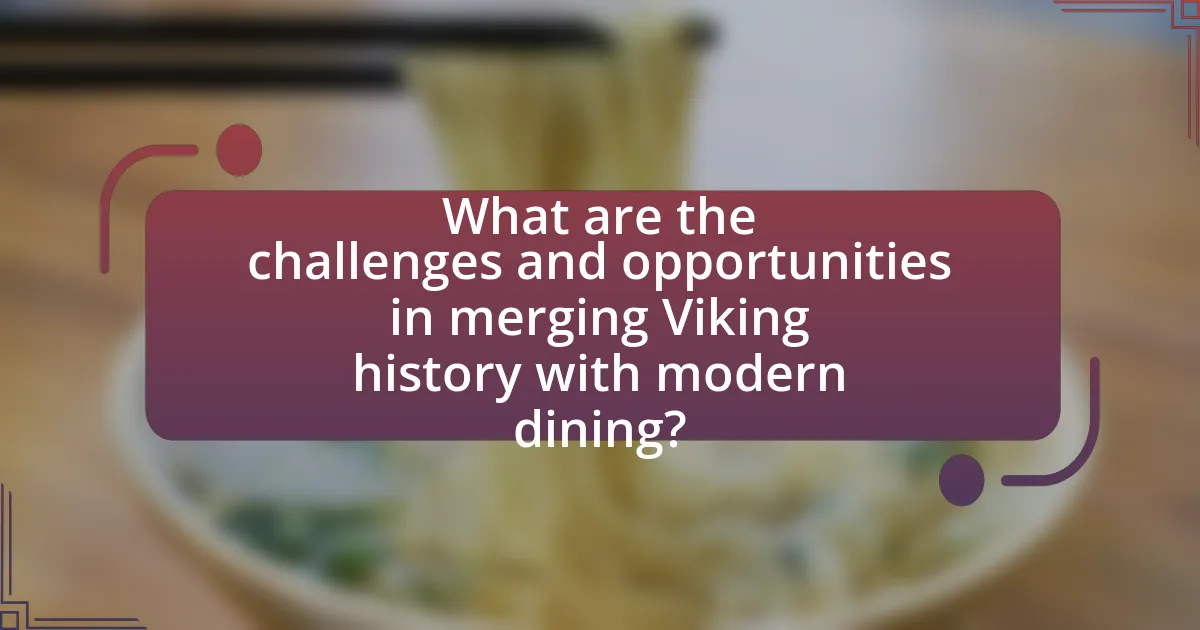
What are the challenges and opportunities in merging Viking history with modern dining?
Merging Viking history with modern dining presents both challenges and opportunities. One significant challenge is the limited availability of authentic Viking ingredients and cooking methods, which can hinder the accurate representation of historical dishes. For instance, traditional Viking diets included items like fermented fish and wild game, which may not appeal to contemporary palates accustomed to modern flavors. Conversely, an opportunity lies in the growing interest in historical and experiential dining, allowing restaurants to create unique culinary experiences that educate diners about Viking culture while incorporating modern culinary techniques. This fusion can attract a niche market interested in heritage cuisine, as evidenced by the rise of themed dining experiences that celebrate historical narratives.
What obstacles do chefs face when integrating Viking elements into contemporary cuisine?
Chefs face several obstacles when integrating Viking elements into contemporary cuisine, primarily due to the limited availability of authentic Viking ingredients and the challenge of adapting ancient cooking techniques to modern culinary practices. The historical Viking diet included items such as fermented foods, wild game, and foraged plants, which are not readily accessible in today’s food supply chains. Additionally, chefs must navigate the balance between preserving traditional flavors and meeting contemporary diners’ preferences for taste and presentation. This integration requires a deep understanding of Viking culinary history, which can be difficult to achieve without extensive research and experimentation.
How can chefs balance authenticity with modern dietary preferences?
Chefs can balance authenticity with modern dietary preferences by incorporating traditional Viking ingredients and cooking methods while adapting recipes to meet contemporary dietary needs, such as gluten-free or plant-based options. For instance, chefs can use ancient grains like barley or rye, which were staples in Viking diets, and offer them in forms that cater to gluten-sensitive diners. Additionally, they can create dishes that highlight traditional flavors, such as smoked fish or root vegetables, while ensuring that they are prepared in ways that align with current health trends, like reducing sodium or using healthier fats. This approach not only preserves the essence of Viking culinary heritage but also makes it accessible and appealing to a broader audience, reflecting the growing demand for inclusive dining experiences.
What innovations are emerging from the fusion of Viking and modern culinary practices?
Innovations emerging from the fusion of Viking and modern culinary practices include the incorporation of ancient preservation techniques, such as fermentation and smoking, into contemporary dishes. Modern chefs are reviving Viking methods like pickling and curing, which enhance flavors and extend shelf life, aligning with current trends in sustainable eating. For example, the use of fermented foods, a staple in Viking diets, is gaining popularity in modern gastronomy for its health benefits and unique taste profiles. This blend of historical techniques with modern culinary creativity is reshaping menus and dining experiences in Sweden today.
What practical tips can home cooks use to incorporate Viking influences into their meals?
Home cooks can incorporate Viking influences into their meals by using traditional ingredients such as barley, rye, and root vegetables, which were staples in the Viking diet. These ingredients can be used to create hearty breads, porridge, and stews that reflect the flavors of the Viking era. Additionally, incorporating fish, particularly herring and salmon, aligns with Viking practices of utilizing the abundant seafood available in Scandinavia.
Cooking methods such as smoking, fermenting, and pickling can also be employed to replicate Viking preservation techniques, enhancing the flavors and textures of the dishes. For example, pickling vegetables can add a tangy element reminiscent of Viking cuisine.
Finally, serving meals on wooden platters or using simple, rustic tableware can evoke the dining experience of the Vikings, creating an authentic atmosphere. These practices not only honor Viking culinary traditions but also promote a connection to the historical roots of Swedish dining.


